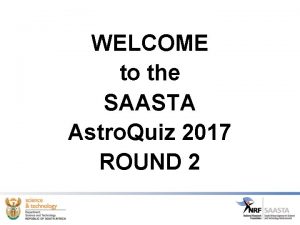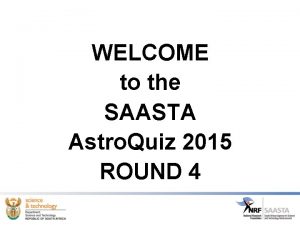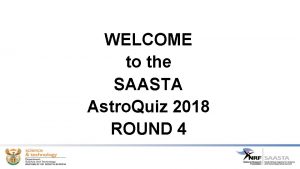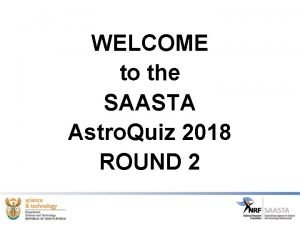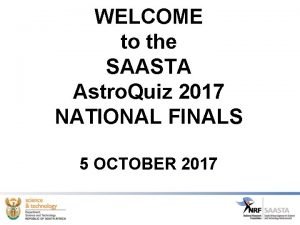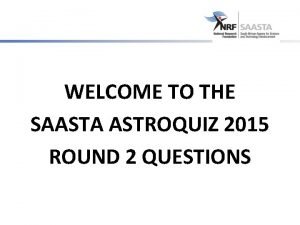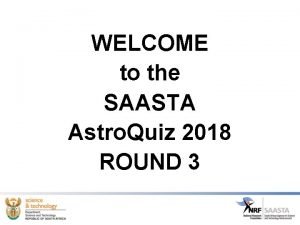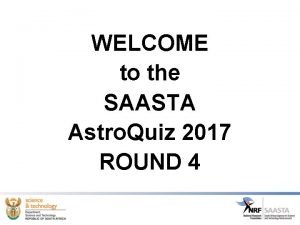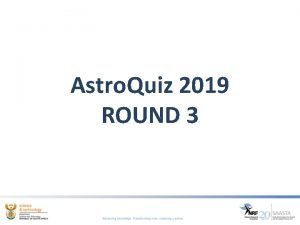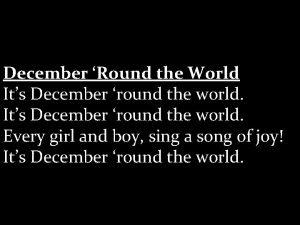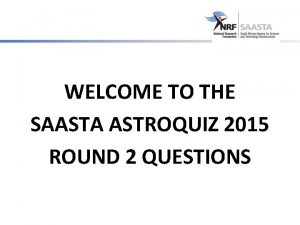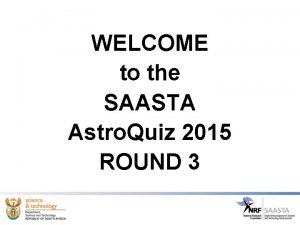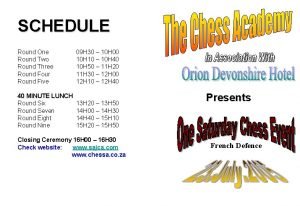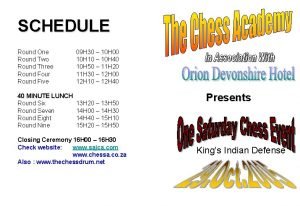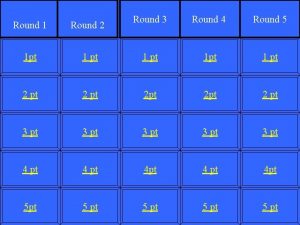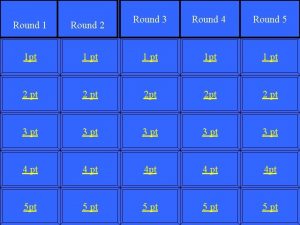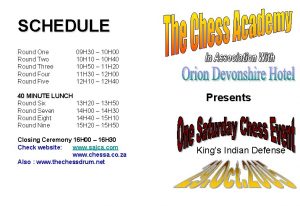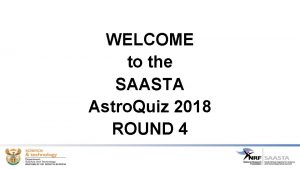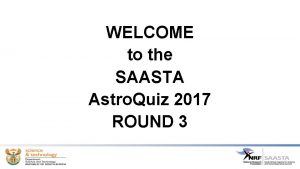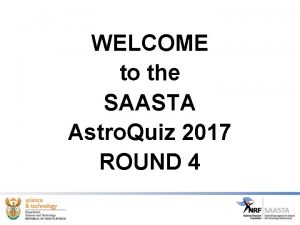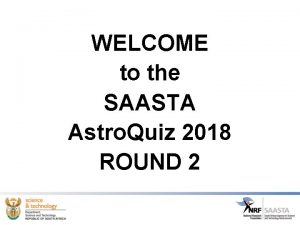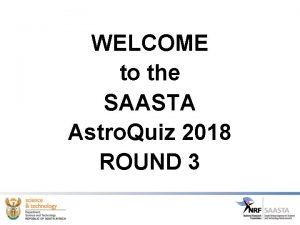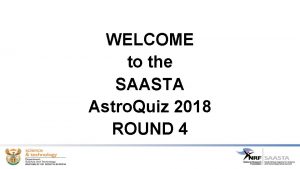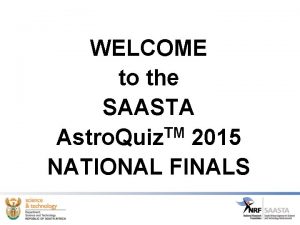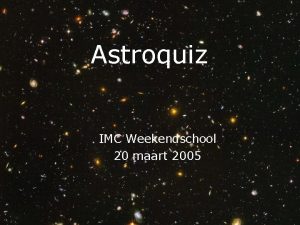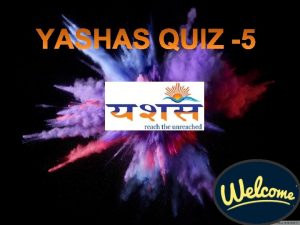WELCOME TO THE SAASTA ASTROQUIZ 2015 ROUND 2












































- Slides: 44

WELCOME TO THE SAASTA ASTROQUIZ 2015 ROUND 2 QUESTIONS

QUESTION 1 One of the following objects plays a role of a big anchor which creates gravity that keeps planets in their respective orbits. A. B. C. D. The Sun The Milky Way Galaxy The Solar System The Moon

QUESTION 2 Which instrument is amongst those used in studying the Sun’s eruptions? A. B. C. D. Monet SKA SALT SOHO

QUESTION 3 When studying the Sun, solar physicists classify it into four domains. In which domain can we find the photosphere? A. B. C. D. The Interior The Corona The Surface atmospheres The Solar Wind

QUESTION 4 The coolest part of the Sun which we can see with our eyes is referred to as the ___ A. B. C. D. Exosphere Corona Chromosphere Photosphere

QUESTION 5 During a total solar eclipse, the disc of the Sun is blocked by the Moon. The part that can be seen during this event is called the ____ A. B. C. D. Exosphere Corona Chromosphere Photosphere

QUESTION 6 The different parts of the Sun rotate at different speeds. This odd behaviour is possible because of ____ A. The Sun being the biggest object in the Solar System B. The Sun being the hottest object in the Solar System C. The Sun not being a solid object D. The Sun not being a stable and constant object

QUESTION 7 The colour of the stars Sirius and the Sun are white and yellow respectively. Which of the following is correct? A. Sirius is colder & brighter than the Sun B. Sirius is hotter & brighter than the Sun C. Both Sirius and the Sun have similar brightness but different temperatures D. The Sun is hotter but not brighter than Sirius

QUESTION 8 When a star shrinks due to lack of fuel, it may shrink into a ______ star. A. Dwarf B. Supernova C. Neon D. Blue

QUESTION 9 Magnitudes give us information about ____ of celestial bodies. A. B. C. D. Size Brightness Shape Mass

QUESTION 10 What is the name of one of the largest optical telescopes in the world that is found in the Northern Cape? A. B. C. D. SAAO SALT HERTZ

QUESTION 11 The Southern African Large Telescope, SALT, is comprised of 91 individual 1 m ______ mirrors. A. Heptagonal B. Hexagonal C. Pentagonal D. Octagonal

QUESTION 12 The Southern African Large Telescope, SALT, has, relative to HET, a redesigned optical system that results in ____ A. A larger field of view and effective collecting area B. The telescope’s view being one of the best C. The objects observed being brought closer to the observer than other telescopes D. That redefines the optical view of the objects

QUESTION 13 During sky viewing, how can one differentiate a planet from a star without using a telescope? A. B. C. D. A star will be bigger than a planet A planet will be bigger than a star A star will twinkle whilst a planet will not A star will have colour whilst a planet will not have colour

QUESTION 14 Which of the following sequences is ordered by increasing size? A. Galaxy; Universe; World; Solar System B. World; Solar System; Universe; Galaxy C. World; Solar System; Galaxy; Universe D. World; Galaxy; Solar System; Universe

QUESTION 15 Which of the following statements is false? A. Galaxies were born after the Universe was created. B. Almost all galaxies have a supermassive black hole at their centres and have different shapes and sizes C. When galaxies collide with each other, they form one small heavy mass of different materials D. Since the universe is expanding and galaxies are moving at high speeds

QUESTION 16 Which two planets amongst the pairs below, are mainly composed of hydrogen and helium gases? A. B. C. D. Mercury & Saturn Jupiter & Saturn Uranus & Mars Jupiter & Mars

QUESTION 17 Which of the following objects does not belong to the group? A. Betelgeuse B. Antares C. Haumea D. Arcturus

QUESTION 18 The year 2015 marks the centenary celebration of a star discovered in Johannesburg. Which star is that? A. Proxima Centauri B. Betelgeuse C. Antares D. Sirius

QUESTION 19 Learners from Sol Plaatje in the North West province had an opportunity of communicating with an astronaut in space on the 2 May 2015. Which one was that? A. Samantha Cristoforetti B. Mark Shuttleworth C. Sharmila Goedhart D. Samantha Onelli

QUESTION 20 The reason why the Sun is visible in the east first is because ______ A. Earth’s rotation is from east to west B. Earth’s rotation is from west to east C. the Sun sets on the west D. The Earth revolves around the Sun once a year

QUESTION 21 Arrange the following objects in order of increasing size. A. Large Magellanic Cloud; Triangulum Galaxy; Milky Way Galaxy; Andromeda Galaxy B. Andromeda Galaxy; Milky Way Galaxy; Triangulum Galaxy; Large Magellanic Cloud C. Large Magellanic Cloud; Andromeda Galaxy; Triangulum Galaxy; Milky Way Galaxy D. Andromeda Galaxy; Triangulum Galaxy; Milky Way Galaxy; Large Magellanic Cloud

QUESTION 22 Which object does not belong to the group below? A. Andromeda galaxy B. Milky Way Galaxy C. Triangulum Galaxy D. Small Magellanic Cloud

QUESTION 23 Which spacecraft is scheduled to fly past Pluto in July 2015 and continue into the Kuiper belt? A. Discovery B. New Horizon C. Dawn D. Curiosity

QUESTION 24 The phenomenon known as “occultation” in astronomy occurs when ____ A. Two planets are seen at the same time in the sky. B. The Moon passes in front of a star. C. A first magnitude star gets close to a less bright star. D. The Earth has made one full revolution around the Sun

QUESTION 25 The Milky way and Andromeda galaxies will one day collide with each other. When that happens the stars in these galaxies won’t collide, this is so because __ A. The stars have enough gravity to be able to avoid each other B. The stars are so far apart that they will simply slide pass one another C. The galaxies will approach each other from their sides which have no stars D. Stars will never collide since they are only made of gases.

QUESTION 26 The robotic space probe Rosetta landed on which object in space in 2014? A. A Moon of Jupiter B. A comet C. An asteroid D. On Mars

QUESTION 27 Which of the following is the correct sequence of Moon phases? A. New moon, first quarter, full moon, third quarter B. First quarter, new moon, full moon, third quarter C. first quarter, full moon, new moon, third quarter D. Full moon, first quarter, new moon, third quarter

QUESTION 28 Radio telescopes are _____ telescopes. A. Refracting B. Reflecting

QUESTION 29 Radio telescopes make use of ____ A. Mirrors B. Lenses

QUESTION 30 What is the smallest of the rocky planets? A. B. C. D. Pluto Ceres Mercury Earth

THANK YOU FOR PARTICIPATING

TIE BREAKERS

QUESTION 1 Which moon has a thick nitrogen atmosphere? A. Mimas B. Janus C. Titan D. Phoebe

QUESTION 2 At which phase of the Moon can a full lunar eclipse occur? A. 1 st Quarter B. New Moon C. 2 nd Quarter D. Full Moon

QUESTION 3 The Sun is at the centre of the __ A. Milky Way B. Solar System C. Andromeda Galaxy D. Universe

QUESTION 4 The facts that Uranus orbits the Sun on its side and has a year of 84 earth years cause summer on each pole to be about … A. 40 years B. 20 years C. 80 years D. 60 years

QUESTION 5 Choose the true statement about Neptune's moon Triton … A. orbits Neptune on its side. B. does not orbit Neptune. C. is Neptune's smallest moon. D. orbits Neptune backwards.

QUESTION 6 The reason why a comet's tail is always pointing away from the Sun is due to ___ A. the comet’s great speed. B. the solar wind. C. the Sun's light. D. unknown to astronomers.

QUESTION 7 During a lunar eclipse the Moon … A. casts its shadow on the Earth. B. is between the Sun and Earth. C. is at the opposite side as the Earth from the Sun. D. is in the shadow of the Earth.

QUESTION 8 The HESS telescope detects … A. X-rays B. cosmic rays C. gamma rays D. radio waves

QUESTION 9 The SAAO concentrates its research at Sutherland on the … A. nature and life cycles of stars B. Southern Cross C. most distance galaxies D. outskirts of the Milky Way.

QUESTION 10 Pluto is classified as a ____ A. planet B. dwarf double planet C. dwarf planet D. pair of moons.

THANK YOU & ALL THE BEST
 Saasta astro quiz 2017 round 1 answers
Saasta astro quiz 2017 round 1 answers Astro quiz 2019 round 1
Astro quiz 2019 round 1 Astro quiz round 2
Astro quiz round 2 Astro quiz 2019 questions and answers round 2
Astro quiz 2019 questions and answers round 2 Saasta astro quiz 2019 questions and answers
Saasta astro quiz 2019 questions and answers Astro quiz round 2
Astro quiz round 2 Saasta astro quiz
Saasta astro quiz Astro quiz round 2
Astro quiz round 2 Astro quiz 2019 questions and answers round 1
Astro quiz 2019 questions and answers round 1 December round the world
December round the world Wise men three clever are we
Wise men three clever are we Từ ngữ thể hiện lòng nhân hậu
Từ ngữ thể hiện lòng nhân hậu Diễn thế sinh thái là
Diễn thế sinh thái là Giọng cùng tên là
Giọng cùng tên là 101012 bằng
101012 bằng Chúa yêu trần thế
Chúa yêu trần thế Khi nào hổ con có thể sống độc lập
Khi nào hổ con có thể sống độc lập đại từ thay thế
đại từ thay thế Vẽ hình chiếu vuông góc của vật thể sau
Vẽ hình chiếu vuông góc của vật thể sau Quá trình desamine hóa có thể tạo ra
Quá trình desamine hóa có thể tạo ra Công của trọng lực
Công của trọng lực Thế nào là mạng điện lắp đặt kiểu nổi
Thế nào là mạng điện lắp đặt kiểu nổi Lời thề hippocrates
Lời thề hippocrates Dot
Dot Bổ thể
Bổ thể Vẽ hình chiếu đứng bằng cạnh của vật thể
Vẽ hình chiếu đứng bằng cạnh của vật thể độ dài liên kết
độ dài liên kết Môn thể thao bắt đầu bằng từ chạy
Môn thể thao bắt đầu bằng từ chạy Sự nuôi và dạy con của hươu
Sự nuôi và dạy con của hươu điện thế nghỉ
điện thế nghỉ Thế nào là sự mỏi cơ
Thế nào là sự mỏi cơ Một số thể thơ truyền thống
Một số thể thơ truyền thống Trời xanh đây là của chúng ta thể thơ
Trời xanh đây là của chúng ta thể thơ Gấu đi như thế nào
Gấu đi như thế nào Thiếu nhi thế giới liên hoan
Thiếu nhi thế giới liên hoan Thế nào là số nguyên tố
Thế nào là số nguyên tố Tỉ lệ cơ thể trẻ em
Tỉ lệ cơ thể trẻ em Phối cảnh
Phối cảnh Các châu lục và đại dương trên thế giới
Các châu lục và đại dương trên thế giới Thế nào là hệ số cao nhất
Thế nào là hệ số cao nhất Hệ hô hấp
Hệ hô hấp Tư thế ngồi viết
Tư thế ngồi viết Hình ảnh bộ gõ cơ thể búng tay
Hình ảnh bộ gõ cơ thể búng tay đặc điểm cơ thể của người tối cổ
đặc điểm cơ thể của người tối cổ
